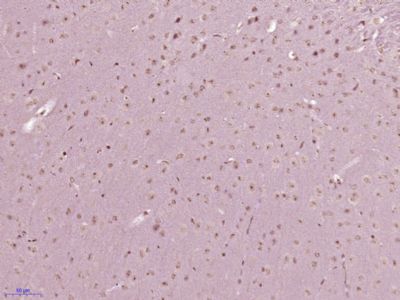MBTD1 Polyclonal Antibody
Purified Rabbit Polyclonal Antibody (Pab)
- SPECIFICATION
- CITATIONS
- PROTOCOLS
- BACKGROUND

Application
| IHC-P, IHC-F, IF, ICC |
|---|---|
| Primary Accession | Q05BQ5 |
| Reactivity | Rat, Pig, Dog, Bovine |
| Host | Rabbit |
| Clonality | Polyclonal |
| Calculated MW | 71 KDa |
| Physical State | Liquid |
| Immunogen | KLH conjugated synthetic peptide derived from human MBTD1 |
| Epitope Specificity | 301-400/628 |
| Isotype | IgG |
| Purity | affinity purified by Protein A |
| Buffer | 0.01M TBS (pH7.4) with 1% BSA, 0.02% Proclin300 and 50% Glycerol. |
| SUBCELLULAR LOCATION | Nucleus. |
| SIMILARITY | Contains 1 FCS-type zinc finger. Contains 4 MBT repeats. |
| Important Note | This product as supplied is intended for research use only, not for use in human, therapeutic or diagnostic applications. |
| Background Descriptions | The transcriptional repressing Polycomb-group (PcG) family is a part of a cellular memory system responsible for the stable inheritance of gene activity. PcG proteins assemble into multimeric protein complexes, which are involved in maintaining the transcriptional repressive state of genes over successive cell generations. MBTD1 (malignant brain tumor domain containing 1) is a 628 amino acid nuclear protein that belongs to the PcG family of proteins. Existing as a monomer, MBTD1 undergoes alternative splicing events to produce three isoforms. MBTD1 contains one FCS-type zinc finger and four MBT repeats, and is encoded by a gene that maps to human chromosome 17q21.33. Chromosome 17 comprises over 2.5% of the human genome and encodes over 1,200 genes. Two key tumor suppressor genes are associated with chromosome 17, namely, p53 and BRCA1. |
| Gene ID | 54799 |
|---|---|
| Other Names | MBT domain-containing protein 1, MBTD1 |
| Dilution | IHC-P=1:100-500,IHC-F=1:100-500,ICC=1:100-500,IF=1:100-500 |
| Storage | Store at -20 ℃ for one year. Avoid repeated freeze/thaw cycles. When reconstituted in sterile pH 7.4 0.01M PBS or diluent of antibody the antibody is stable for at least two weeks at 2-4 ℃. |
| Name | MBTD1 {ECO:0000303|PubMed:23915195, ECO:0000312|HGNC:HGNC:19866} |
|---|---|
| Function | Chromatin reader component of the NuA4 histone acetyltransferase complex, a multiprotein complex involved in transcriptional activation of select genes principally by acetylation of nucleosomal histones H4 and H2A (PubMed:27153538, PubMed:32209463). The NuA4 complex plays a direct role in repair of DNA double-strand breaks (DSBs) by promoting homologous recombination (HR) (PubMed:27153538). MBTD1 specifically recognizes and binds monomethylated and dimethylated 'Lys-20' on histone H4 (H4K20me1 and H4K20me2, respectively) (PubMed:19841675, PubMed:27153538, PubMed:32209463). In the NuA4 complex, MBTD1 promotes recruitment of the complex to H4K20me marks by competing with TP53BP1 for binding to H4K20me (PubMed:27153538). Following recruitment to H4K20me at DNA breaks, the NuA4 complex catalyzes acetylation of 'Lys-15' on histone H2A (H2AK15), blocking the ubiquitination mark required for TP53BP1 localization at DNA breaks, thereby promoting homologous recombination (HR) (PubMed:27153538). |
| Cellular Location | Nucleus. Chromosome |

Thousands of laboratories across the world have published research that depended on the performance of antibodies from Abcepta to advance their research. Check out links to articles that cite our products in major peer-reviewed journals, organized by research category.
info@abcepta.com, and receive a free "I Love Antibodies" mug.
Provided below are standard protocols that you may find useful for product applications.
If you have used an Abcepta product and would like to share how it has performed, please click on the "Submit Review" button and provide the requested information. Our staff will examine and post your review and contact you if needed.
If you have any additional inquiries please email technical services at tech@abcepta.com.













 Foundational characteristics of cancer include proliferation, angiogenesis, migration, evasion of apoptosis, and cellular immortality. Find key markers for these cellular processes and antibodies to detect them.
Foundational characteristics of cancer include proliferation, angiogenesis, migration, evasion of apoptosis, and cellular immortality. Find key markers for these cellular processes and antibodies to detect them. The SUMOplot™ Analysis Program predicts and scores sumoylation sites in your protein. SUMOylation is a post-translational modification involved in various cellular processes, such as nuclear-cytosolic transport, transcriptional regulation, apoptosis, protein stability, response to stress, and progression through the cell cycle.
The SUMOplot™ Analysis Program predicts and scores sumoylation sites in your protein. SUMOylation is a post-translational modification involved in various cellular processes, such as nuclear-cytosolic transport, transcriptional regulation, apoptosis, protein stability, response to stress, and progression through the cell cycle. The Autophagy Receptor Motif Plotter predicts and scores autophagy receptor binding sites in your protein. Identifying proteins connected to this pathway is critical to understanding the role of autophagy in physiological as well as pathological processes such as development, differentiation, neurodegenerative diseases, stress, infection, and cancer.
The Autophagy Receptor Motif Plotter predicts and scores autophagy receptor binding sites in your protein. Identifying proteins connected to this pathway is critical to understanding the role of autophagy in physiological as well as pathological processes such as development, differentiation, neurodegenerative diseases, stress, infection, and cancer.


